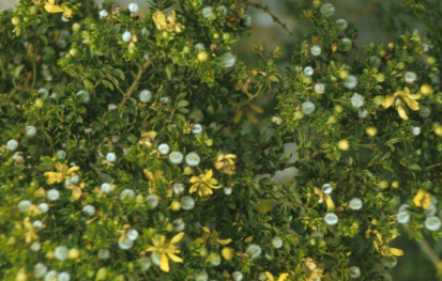Larrea mexicana

Synonyms: Larrea tridentata, L.divaricata (L), L.glutinosa, creosote bush, greasewood, gobernadora, hediondilla
Order: Zygophyllaceae

Description: Larrea is a many-branched shrub with waxy green leaves and yellow flowers. It is a common native of the southern US and Mexico.
Parts used: leaves and flowers
Collection: at any time
Constituents: flavone and flavonol aglycones, larreic acid, guaiuretic acid lignans including nordihydroguaiaretic acid, quercetin bioflavonoids
Actions: antimicrobial, antioxidant, anti-inflammatory
Indications: skin disorders, rheumatism, arthritis, bursitis
Therapeutics and Pharmacology: Larrea is a useful topical treatment for abrasions and wounds. In addition to its antibiotic and anti-inflammatory properties, Larrea is a useful respiratory and urinary antiseptic. It has a history of use in the treatment of skin cancers and is regarded as a panacea by the Arizona natives. Internally, it has been shown to inhibit free-radical damage to the liver and lungs. It is a traditional remedy for cancer, but research has shown that while it can indeed inhibit the growth of cancer cells, it can also stimulate their growth. Nordihydroguaiaretic acid is a powerful parasiticide.
Combinations: Larrea may be combined with Carduus to inhibit free-radical damage.
Caution: Larrea is currently banned from general sale in the US and UK as it has been suggested that it may actually stimulate the growth of cancer cells.
Additional Comments: The southwestern Native Americans use Chaparral as a liniment for swollen limbs caused by poor circulation. A decoction of the leaves is used to relieve bowel cramps. The crushed leaf powder is applied to sores and wounds, and to promote the healing of babies' navels, while a poultice of the chewed leaves can be applied to scorpion or spider bites. The branches of the shrub may be used as roofing and to knock the spines off prickly pears. Larrea charcoal, which is greenish-blue in colour, is sometimes used as a dye for tattoos. The early settlers used it as a treatment for venereal disease.
Bibliography:
Bartram, T. 1995 Encyclopedia of Herbal Medicine, 1st edn., Grace Publishers, Bournemouth.
Moerman, D. 1998 Native American Ethnobotany, Timber Press, Portland, Oregon.
Moore, M. 1989 Medicinal Plants of the Desert and Canyon West, Museum of New Mexico Press, Santa Fe.










